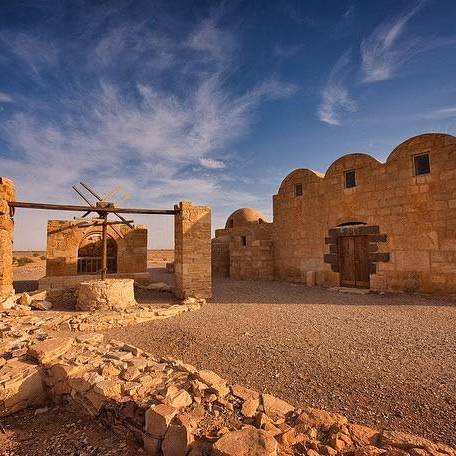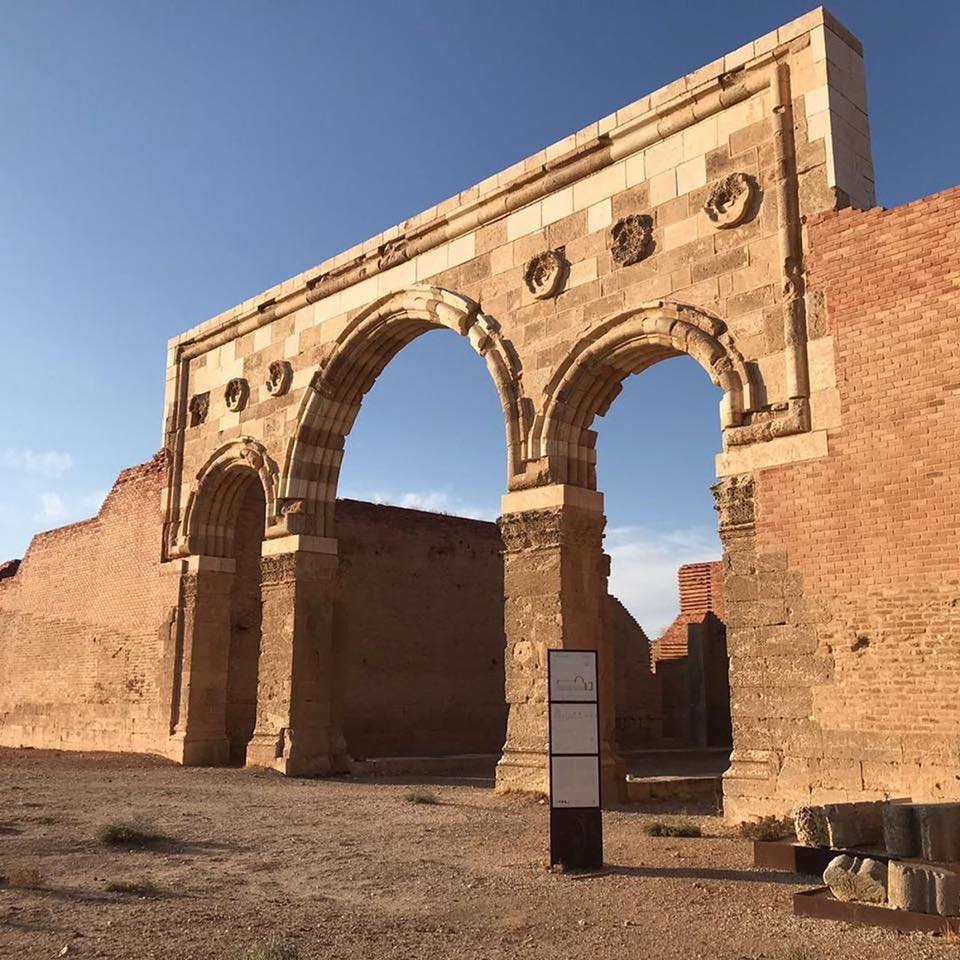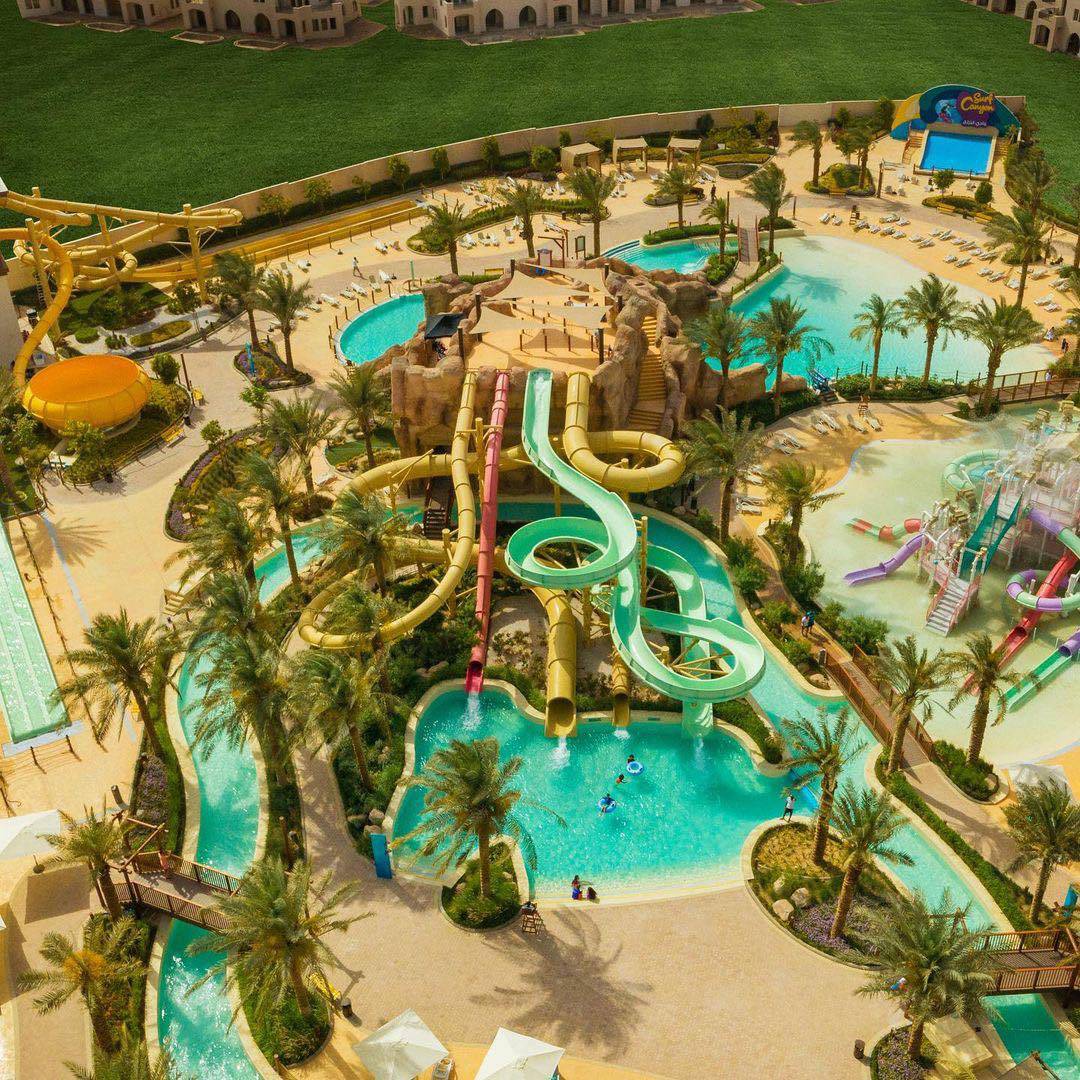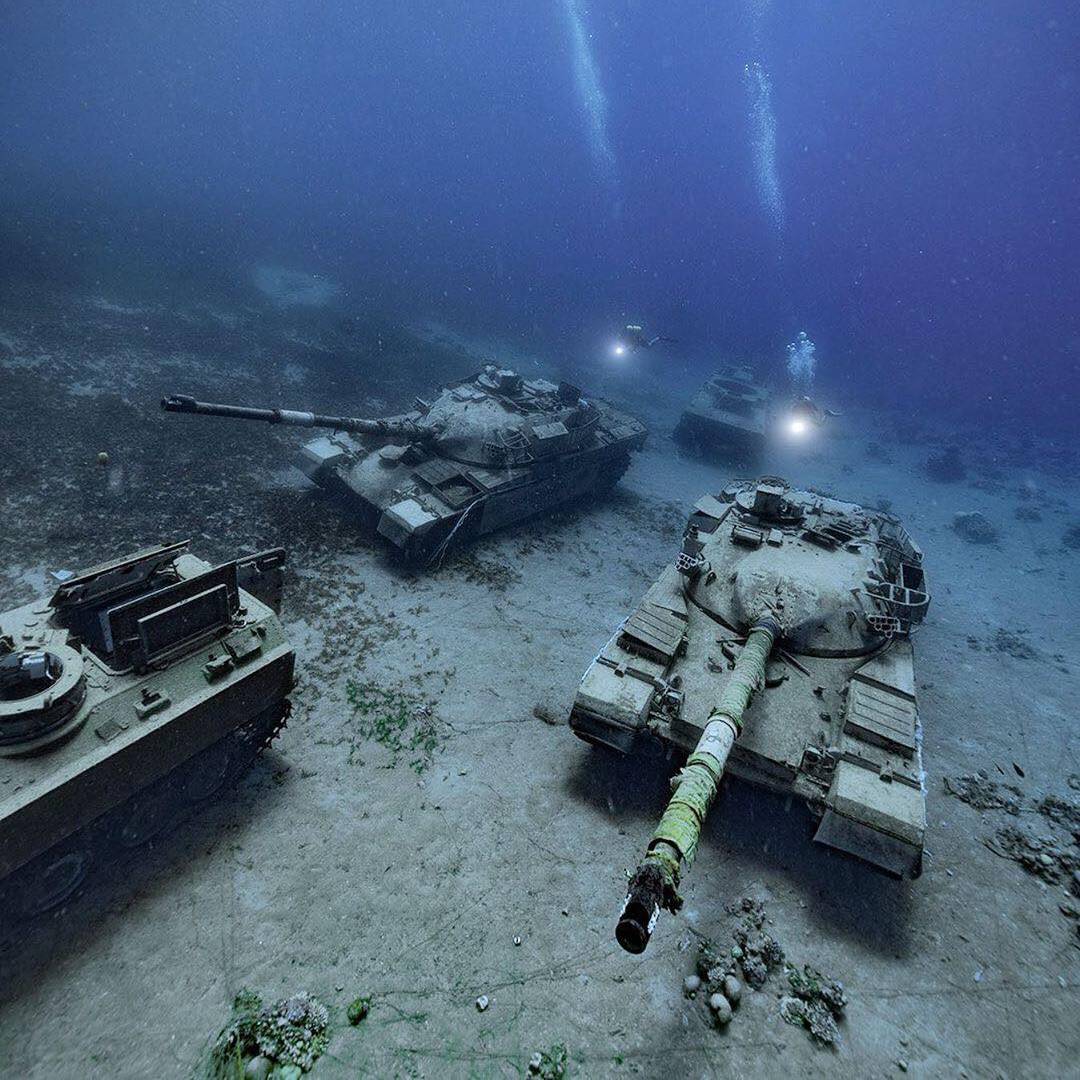
Home < Jordan < Amra Castle Amra Castle Amra Castle, also known as Qasr Amra, is a remarkable UNESCO World Heritage Site located in the desert of eastern Jordan. It is one of the desert castles that dot the landscape of the region, each with its own historical significance. Qasr Amra is particularly renowned for its unique frescoes and its representation of early Islamic art and architecture. Constructed during the early 8th century, Qasr Amra served as a luxurious hunting lodge, bathhouse, and retreat for the Umayyad caliphs. Its relatively small size and remote location make it stand out among the desert castles, as it was not a defensive fortress but rather a place of relaxation and indulgence. What sets Qasr Amra apart are its stunning frescoes that adorn the interior walls and ceilings. These frescoes depict a wide range of subjects, including portraits of rulers, scenes of courtly life, mythological figures, and even astronomical and astrological representations. These paintings provide valuable insights into the art, culture, and daily life of the Umayyad period. The frescoes also feature inscriptions in Kufic script, providing historical and religious context to the scenes. These inscriptions include verses from the Quran, poetic lines, and dedicatory phrases, further enriching the cultural significance of the site. Qasr Amra’s architecture showcases a blend of Roman, Byzantine, and Persian influences, combined with the distinctive elements of Islamic architecture. The complex includes a central courtyard, a domed reception hall, a bathhouse, and various rooms. Despite its desert location, Qasr Amra served as a testament to the Umayyad caliphs’ appreciation for art, culture, and luxury. Its frescoes and architecture provide a glimpse into the cosmopolitan and intellectually rich society of the early Islamic world. Today, Qasr Amra stands as a unique historical site that offers visitors a chance to explore the artistry, symbolism, and lifestyle of the Umayyad dynasty. It serves as a tangible link to the past, allowing us to connect with the creativity and sophistication of an era that greatly influenced the development of Islamic culture and civilization. Home < Jordan < Amra Castle

Home < Jordan < Al Mushatta Palace Al Mushatta Palace Al-Mushatta Palace, located in Jordan, is an archaeological site that holds the remnants of a once-grand palace complex. The site is significant not only for its historical and architectural value but also for the intricate decorative elements that adorned its walls. The palace was constructed during the Umayyad period, specifically in the 8th century, under the rule of Caliph Al-Walid II. It was situated near modern-day Amman and is part of the historical region of Bilad al-Sham. The palace complex showcased the opulence and sophistication of Umayyad architecture and lifestyle. One of the most notable features of Al-Mushatta Palace is its ornate decorative designs, particularly the intricate stucco carvings that adorned the exterior and interior walls. These carvings showcased geometric patterns, floral motifs, and scenes of hunting, animals, and human figures. The stucco work at Al-Mushatta is celebrated for its complexity, precision, and the artistry displayed in its execution. Although Al-Mushatta Palace was never fully completed, it provides insights into the architectural style and luxurious tastes of the Umayyad dynasty. The palace was constructed using a combination of local limestone and colored stones, creating a visual tapestry that reflected the artistic influences of the time. Tragically, the palace suffered damage and partial destruction due to a variety of historical events, including earthquakes and conflicts. Additionally, fragments of the palace’s intricate stucco carvings were removed and are now housed in museums around the world, contributing to a deeper understanding of Umayyad art and culture. Despite its current state of ruin, Al-Mushatta Palace remains an important site for understanding the architectural achievements and cultural richness of the Umayyad period. The remnants of its decorative elements and its historical significance continue to attract scholars, archaeologists, and visitors interested in exploring Jordan’s rich heritage. Home < Jordan < Al Mushatta Palace

Home < Jordan < Kerak Castle Kerak Castle Kerak Castle, also known as Al-Karak Castle, is a historic fortress located in the town of Al-Karak in Jordan. It is one of the most significant and well-preserved castles from the Crusader period in the region. The castle’s strategic location atop a hill provides commanding views of the surrounding landscape and was vital for controlling trade routes and protecting the area. Constructed during the 12th century by the Crusaders, the castle was later expanded and fortified by various rulers and civilizations, including the Mamluks and the Ottomans. Its thick walls, imposing towers, and intricate architecture showcase a blend of military functionality and artistic design. Kerak Castle’s complex layout includes tunnels, dungeons, halls, and courtyards. It served not only as a military stronghold but also as a center of governance, housing facilities for soldiers, residences, and storage areas. The castle’s design and structure were influenced by both European Crusader and Islamic architectural styles, reflecting the cultural exchange of the time. Visitors to Kerak Castle can explore its various sections, including its maze-like passageways, dark chambers, and terraces. The castle’s museum exhibits artifacts and information about its history, architecture, and the various civilizations that influenced its development. One of the notable features of Kerak Castle is the underground water cisterns, which were crucial for supplying water to the castle’s inhabitants during times of siege. These cisterns demonstrate the ingenuity of the castle’s builders in managing precious resources. The castle’s historical significance and captivating architecture make it a popular destination for tourists and history enthusiasts alike. Standing as a silent witness to centuries of history and conflicts, Kerak Castle invites visitors to step back in time and imagine the lives of those who lived within its walls. The panoramic views from its vantage points also offer a glimpse into the stunning landscapes that surround this ancient fortress. Home < Jordan < Kerak Castle

Home < Jordan < Ajloun Castle Ajloun Castle The Ajloun Castle, also known as Qala’at Al-Rabad, stands as a historic masterpiece and a testament to the rich heritage of Jordan. Situated atop a hill in the Ajloun Governorate, this medieval fortress holds a significant place in the region’s history and offers visitors a captivating journey into the past. Dating back to the 12th century, the Ajloun Castle was strategically built by the famous Islamic general Salah ad-Din (Saladin) to control and protect the surrounding lands. The castle’s imposing walls, watchtowers, and battlements reflect its original purpose as a defensive stronghold. The stone architecture, marked by sturdy construction and meticulous craftsmanship, stands as a testament to the architectural prowess of the era. Exploring the castle transports visitors to a time when military and architectural ingenuity came together. As you traverse its narrow passageways, climb its spiral staircases, and peer through arrow slits, you’ll gain a deep appreciation for the castle’s strategic design. From its vantage point, the panoramic views of the surrounding countryside are awe-inspiring, offering a glimpse into the historical context of its location. The Ajloun Castle also serves as a museum, housing an array of artifacts, exhibits, and informational displays that shed light on the castle’s history, its role in the region’s conflicts, and the daily lives of its inhabitants. As you meander through its rooms, halls, and courtyards, you’ll uncover stories of battles, conquests, and the ebb and flow of life within its walls. Beyond its historical significance, the Ajloun Castle offers a tranquil escape from the hustle and bustle of modern life. The serene surroundings and the whispers of history that linger within its stone walls make it a contemplative space where visitors can reflect on the passage of time and the enduring legacies of the past. Visiting the Ajloun Castle is not just a journey into history; it’s an opportunity to connect with the narratives of the past and appreciate the architectural wonders that have withstood the test of time. As you explore its nooks and crannies, you’ll embark on a voyage of discovery that bridges the gap between the present and the echoes of ancient civilizations. Home < Jordan < Ajloun Castle

Home < Jordan < Saraya Water Park Saraya Water Park The Saraya Aqaba Water Park is a fantastic destination for families and water enthusiasts seeking a fun and refreshing escape in the vibrant city of Aqaba. Nestled within the Saraya Aqaba development, this water park offers a haven of aquatic adventures and relaxation against the stunning backdrop of the Red Sea. The water park boasts a diverse range of attractions that cater to visitors of all ages. For thrill-seekers, towering water slides provide heart-pounding drops and twists, offering an adrenaline rush that is sure to delight. Those looking for a more relaxed experience can float along lazy rivers, bask in the sun on comfortable loungers, or dip into inviting pools. Younger visitors are not forgotten, as the Saraya Aqaba Water Park offers dedicated play areas and shallow pools designed with safety and entertainment in mind. The cheerful splash zones, water sprays, and interactive features create a space where children can have endless fun in a secure environment. Beyond the exhilarating rides and serene retreats, the water park provides a variety of dining options that cater to different tastes. From casual snacks to full meals, visitors can refuel and recharge to continue their aquatic adventures. One of the water park’s unique features is its integration with the natural beauty of Aqaba. With views of the Red Sea and surrounding landscapes, guests can enjoy the best of both worlds—the excitement of water attractions and the tranquility of the stunning coastal scenery. Saraya Aqaba Water Park goes beyond being just a place for fun; it’s a destination where families and friends can create lasting memories while indulging in the joys of water-based entertainment. Whether you’re seeking a thrilling adventure, a relaxing retreat, or a day of family bonding, the Saraya Aqaba Water Park offers an immersive experience that captures the spirit of Aqaba’s beauty and excitement. Home < Jordan < Saraya Water Park

Home < Jordan < Water Activities Water Activities Nestled along the captivating shores of the Red Sea, Aqaba stands as a gateway to an awe-inspiring world of aquatic wonders and thrilling activities. With its crystal-clear waters and diverse marine ecosystems, Aqaba offers a captivating array of experiences for water enthusiasts of all kinds. Beneath the surface, vibrant coral reefs burst with a kaleidoscope of colors and teem with an astonishing variety of marine life, beckoning both snorkelers and divers to explore the depths of this underwater paradise. From the novice to the experienced, these underwater adventures offer a unique opportunity to connect with the intricate beauty of the marine world. For those seeking an adrenaline rush, Aqaba’s coastline offers a playground of excitement. Jet skiing and parasailing allow you to skim across the water’s surface and feel the wind in your hair, while the exhilarating thrill of banana boat rides promises laughter and memories. The Red Sea’s consistent winds also make Aqaba a prime destination for kiteboarding and windsurfing, where enthusiasts can harness the power of nature to glide over the waves, creating a dance of exhilaration and skill. Yet Aqaba is not only about high-octane excitement; it also invites visitors to unwind and indulge in relaxation. Glass-bottom boat tours provide a unique opportunity to witness the underwater spectacle without getting wet, offering panoramic views of the marine life and coral formations beneath the waves. Serene sunset cruises, whether on traditional wooden boats or modern yachts, allow you to bask in the tranquil beauty of the sea as the sun sets over the horizon. Meanwhile, fishing excursions invite you to connect with nature and experience the art of angling, surrounded by the coastal landscape and the rhythmic sound of lapping waves. Aqaba’s appeal as a water paradise extends beyond the activities themselves—it’s about the connection it fosters between visitors and the sea. The Red Sea’s allure, combined with the diverse offerings of Aqaba, promises an unforgettable journey into the heart of aquatic beauty, adventure, and relaxation. Whether you’re seeking to dive into vibrant underwater realms, embrace the thrill of water sports, or simply unwind amidst breathtaking coastal vistas, Aqaba offers an aquatic tapestry of experiences that cater to every water lover’s desire. Home < Jordan < Water Activities

Home < Jordan < Ayla Golf Course Ayla Golf Course Ayla Golf Course in Aqaba, Jordan, is a renowned golf destination known for its picturesque setting and challenging layout. Ayla Golf Course is part of the Ayla Oasis development, which is a luxury residential and leisure community located along the shores of the Red Sea in Aqaba. The golf course was designed by Greg Norman, the famous Australian professional golfer and golf course architect. It offers golfers a unique experience with stunning views of the Red Sea and the surrounding mountains, creating a beautiful backdrop while playing. Ayla Golf Course features an 18-hole championship course that provides golfers of all levels with an exciting and challenging game. The course design takes advantage of the natural terrain, incorporating water features, bunkers, and undulating greens, making it an enjoyable experience for golf enthusiasts. Home < Jordan < Ayla Golf Course

Home < Jordan < Underwater Military Museum Underwater Military Museum This underwater museum is one of the first of its kind in the world and offers a fascinating blend of history and marine conservation. The museum features several decommissioned military vehicles and equipment that have been purposefully submerged to create an artificial reef and an underwater exhibit. The idea behind the project was to provide an alternative to conventional coral reefs, which are facing threats from pollution and climate change, and to create an environment that promotes marine life and biodiversity. Visitors who are certified divers have the opportunity to explore the submerged military vehicles up close, including tanks, helicopters, and other military equipment. The site has become a popular diving destination, attracting diving enthusiasts and history lovers alike. The underwater museum not only offers a unique experience for divers but also serves as a reminder of Jordan’s military history and the efforts being made to protect and preserve marine ecosystems. Home < Jordan < Underwater Military Museum

Home < Jordan < St. George’s Church St’ George’s Church St. George’s Church in Madaba, Jordan, is one of the city’s most famous and significant historical sites. The church is renowned for housing the ancient mosaic map of the Holy Land, often referred to as the “Madaba Map.” This mosaic is a masterpiece of early cartography and one of the most important archaeological discoveries in the region. The Madaba Map is believed to date back to the 6th century AD and covers the floor of the church’s nave. It depicts the eastern Mediterranean region, including Palestine, the Dead Sea, the Jordan River, and the surrounding areas. The map provides valuable insights into the geography, topography, and urban layout of the Holy Land during that time. The mosaic is made up of more than two million pieces of colored stone and has been meticulously restored over the years. It showcases various cities, towns, rivers, and biblical sites, including Jerusalem and Bethlehem. The Madaba Map has been instrumental in helping historians and archaeologists understand the geography and religious significance of the region during the Byzantine period. Apart from the Madaba Map, St. George’s Church itself is a significant religious site for Christians. The church was originally constructed in the 6th century AD, and it has undergone several renovations and additions over the centuries. Visitors to the church can also see other impressive mosaic floors and artwork, adding to the richness of the site. St. George’s Church is a popular tourist attraction and pilgrimage site, drawing visitors from all around the world who come to admire the ancient mosaic map and explore the historical and religious heritage of Madaba. Home < Jordan < St. George’s Church










